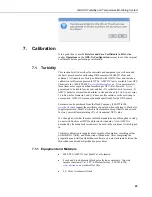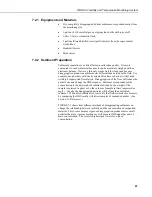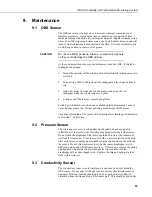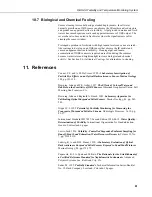
OBS-3A Turbidity and Temperature Monitoring System
9. Maintenance
9.1 OBS Sensor
The OBS sensor must be kept clean to measure sediment concentration or
turbidity accurately. A gradual decline in sensitivity over a period of time
indicates fouling with mud, oil, or biological material. Regular cleaning with a
water jet, mild detergent and warm water, or a Scotch-brite® abrasive pad will
remove most contaminants encountered in the field. Solvent or mineral spirits
on cloth can be used to remove oil or grease.
Do not use MEK, benzene, toluene, or electronic cleaners
as they could damage the OBS window.
CAUTION
At the conclusion of each survey or deployment, clean the OBS. If thick bio-
fouling has developed:
1.
Scrape the material off the window with a flexible knife, taking care not to
scratch it.
2.
Tape a strip of 400 to 600-grit wet/dry sandpaper on the edge of a bench
top.
3.
Add a few drops of water and rub the sensor window on the wet
sandpaper, using the counter edge for a guide.
4.
Continue until the sensor is smooth and pit-free.
Polishing with abrasives can be done as needed until approximately 1 mm of
epoxy has been removed. Deeper polishing may damage the IR source.
Check the calibration of the sensor with formazin after cleaning with abrasives;
see Section 7,
Calibration
.
9.2 Pressure Sensor
The strain gage sensor is located under a perforated disk and spring-clip
(FIGURE 6-1) that protects the Hastelloy diaphragm isolating it from water.
Do not touch the diaphragm with tools or pointed objects, as the instrument
will leak if it is pierced. Clean the sensor with a water jet directed at the disk
after each survey or deployment to flush sediment from between the disk and
the sensor. Do not allow sediment to dry on the sensor diaphragm, as it is
difficult to clean and will influence accuracy. If this occurs, remove the spring
clip and disk with plastic tweezers then gently wipe sediment off the
diaphragm with a cotton-tipped swab. Replace the disk and spring clip then
flush with a water jet.
9.3 Conductivity Sensor
The conductivity sensor is very fragile and is enclosed in a hole behind the
OBS sensor. Do not poke it with any tool or object as the electrodes may be
damaged. Routine cleaning should only be done with a water jet directed
alternately from the side and top of the sensor well. This should be done daily
53


























